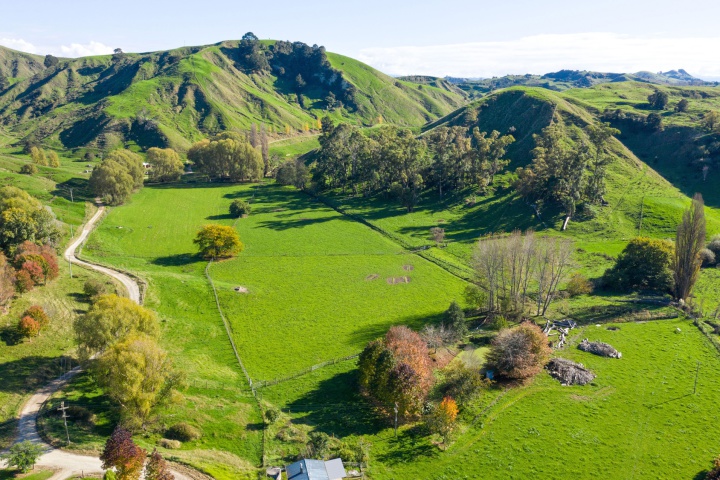Large-scale dairy conversion with own lake-sized reservoir
Media Release
24.6.2019.
Large-scale dairy conversion farm with its own lake-sized reservoir placed on the market for sale
A large-scale dairy conversion farm – complete with a huge lake-like reservoir –which has seen primary sheep and beef production replaced over the past decade in favour of milking, has been placed on the market for sale.

Caption goes here
Strathallan Station some 26-kilometres north-west of Gisborne is a 1,213-hectare property currently milking a herd of 1,000 cows. Towards the centre of the property is a two-and-a-half-metre-deep ‘reservoir’ lake large enough for recreational kayaking and duck hunting. The reservoir sustains not only the farm’s irrigation needs, but also its milk shed requirements.
The property was originally run as a sheep and beef breeding and fattening unit before undergoing conversion to dairying in 2009. Strathallan Station has been operating a once-a-day milking programme – producing 254,567 kilogrammes of milk solids PLUS feeding 800 calves (20,000 milk solids) in the 2018/19 season.
Now the freehold property at 198 Humphreys Road in Waipaoa is being marketed for sale by tender through Bayleys Gisborne, with tenders closing at 4pm on July 17. Bayleys Gisborne salespeople Simon Bousfield and James Bolton-Riley said Strathallan Station was located at between 40 – 240 metres above sea level.
Mr Bousfield said the farm had
access to superb reticulation from a large
Manmade 1,800
square metre reservoir located near the milking shed –
with water filtered and pumped to a 30,000 litre holding
tank before being treated through a dosatron, then
circulated around the block to various other tanks and
reticulated to large troughs.

Caption goes here
He said additional water supplies to service the domestic quartet of farm dwellings on the property was sourced from a natural clear water well.
“The farm is consented to run up to 1,100 cows. Stock production records show Strathallan Station reared 800 calves and of the 400 heifer calves, some 200 heifer calves exported predominantly for export to Asia. In addition, the property produced 400 bull calves sold at various ages, 200 cows and 100 bulls to meat processing works,” Mr Bousfield said.
“The property has consent to take on an additional 100 cows under its split milking permutation.”
Farm building infrastructure on the
Waipaoa property consists of:
• A fully automated
54-bail Westfalia rotary milking shed built in 2010 milking
the farm’s two herds of 500 cows each on a once-a-day
basis
• A large nine bay calf-rearing and implement
storage shed
• A now dormant 264 square metre
six-stand woolshed immediately adjacent to 302 square metres
of covered yards suitable for handling calves.
• An
effluent treatment pond consented to take in excrement from
a herd of more than 1000 cows with a pumping plant spreading
byproduct across the lower paddocks
• An additional
pair of workshops and high-stud implement storage
sheds
and
• Some 1,000 square metres of feed
bunkers and concreted feed pad yard utilised for feeding out
a combination of local cheap bought-in waste vegetable
(tomatoes, squash) mix.
A 25-tonne silo with built-in auger is installed for in-shed feed system. Local kibbled maize is readily available.
Meanwhile, accommodation on
the Waipaoa property consists of four residential dwellings
sustaining the four full-time staff, encompassing:
• A
six-bedroom/two-bathroom character homestead constructed at
the turn of the last century and now with recreational
amenities including a swimming pool and concrete tennis
court
• A three-bedroom manager’s home with a
separate two-bedroom sleep-out
and
• A pair of
three-bedroom Lockwood staff homes.
Mr Bolton-Riley said the property’s topography predominantly consisted of rolling paddocks and easy hill country adjacent to some 40 hectares of flat land – sustaining an effective milking area of 700 hectares.
He said Strathallan Station had been subdivided into 218 paddocks as part of the dairying conversion – with the paddocks separated by conventional post and batten fencing on the larger paddocks and sectioned into smaller blocks by electric fencing.
All the paddocks are accessed by well-maintained stock movement lanes. Strathallan Station is fully contained – 2000 cattle are wintered on farm including all milking cows, he said.


 The Conversation: NZ’s Glaciers Have Already Lost Nearly A Third Of Their Ice – As More Vanishes, Landscapes And Lives Change
The Conversation: NZ’s Glaciers Have Already Lost Nearly A Third Of Their Ice – As More Vanishes, Landscapes And Lives Change RBNZ: Reserve Bank Of New Zealand Welcomes The Release Of Te Ōhanga Māori 2023 Report
RBNZ: Reserve Bank Of New Zealand Welcomes The Release Of Te Ōhanga Māori 2023 Report Bill Bennett: Download Weekly - One NZ chooses Ericsson for core network update
Bill Bennett: Download Weekly - One NZ chooses Ericsson for core network update Mountains to Sea Conservation Trust: Orange Roughy Leads The Pack As Fish Of The Year Heats Up
Mountains to Sea Conservation Trust: Orange Roughy Leads The Pack As Fish Of The Year Heats Up Hugh Grant: Retail Crime Is Out Of Control – Why Business Owners Can’t Wait For Government Action
Hugh Grant: Retail Crime Is Out Of Control – Why Business Owners Can’t Wait For Government Action SkyCity Auckland: Sky Tower Glows For International Women’s Day
SkyCity Auckland: Sky Tower Glows For International Women’s Day



